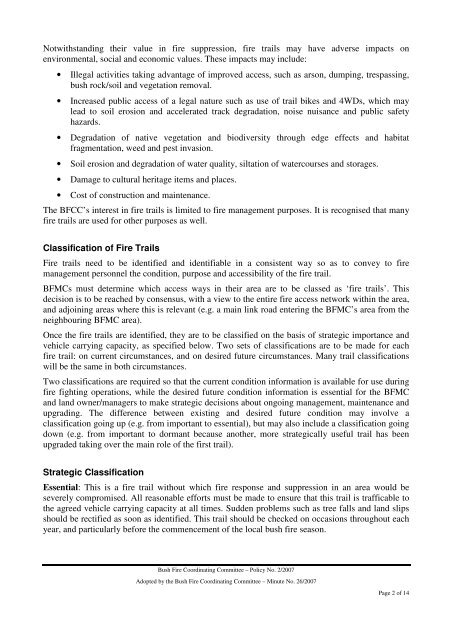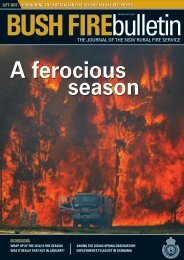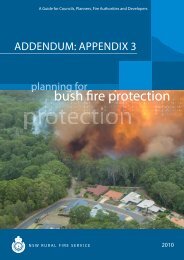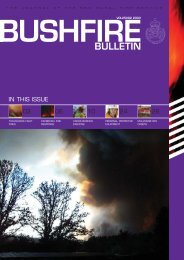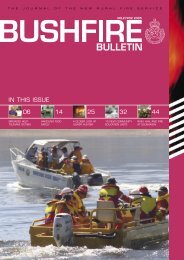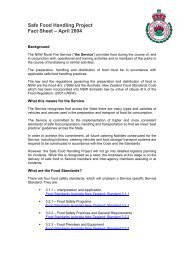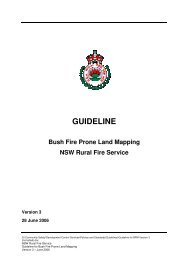POLICY NO. 2/2007 FIRE TRAILS - NSW Rural Fire Service
POLICY NO. 2/2007 FIRE TRAILS - NSW Rural Fire Service
POLICY NO. 2/2007 FIRE TRAILS - NSW Rural Fire Service
You also want an ePaper? Increase the reach of your titles
YUMPU automatically turns print PDFs into web optimized ePapers that Google loves.
Notwithstanding their value in fire suppression, fire trails may have adverse impacts on<br />
environmental, social and economic values. These impacts may include:<br />
• Illegal activities taking advantage of improved access, such as arson, dumping, trespassing,<br />
bush rock/soil and vegetation removal.<br />
• Increased public access of a legal nature such as use of trail bikes and 4WDs, which may<br />
lead to soil erosion and accelerated track degradation, noise nuisance and public safety<br />
hazards.<br />
• Degradation of native vegetation and biodiversity through edge effects and habitat<br />
fragmentation, weed and pest invasion.<br />
• Soil erosion and degradation of water quality, siltation of watercourses and storages.<br />
• Damage to cultural heritage items and places.<br />
• Cost of construction and maintenance.<br />
The BFCC’s interest in fire trails is limited to fire management purposes. It is recognised that many<br />
fire trails are used for other purposes as well.<br />
Classification of <strong>Fire</strong> Trails<br />
<strong>Fire</strong> trails need to be identified and identifiable in a consistent way so as to convey to fire<br />
management personnel the condition, purpose and accessibility of the fire trail.<br />
BFMCs must determine which access ways in their area are to be classed as ‘fire trails’. This<br />
decision is to be reached by consensus, with a view to the entire fire access network within the area,<br />
and adjoining areas where this is relevant (e.g. a main link road entering the BFMC’s area from the<br />
neighbouring BFMC area).<br />
Once the fire trails are identified, they are to be classified on the basis of strategic importance and<br />
vehicle carrying capacity, as specified below. Two sets of classifications are to be made for each<br />
fire trail: on current circumstances, and on desired future circumstances. Many trail classifications<br />
will be the same in both circumstances.<br />
Two classifications are required so that the current condition information is available for use during<br />
fire fighting operations, while the desired future condition information is essential for the BFMC<br />
and land owner/managers to make strategic decisions about ongoing management, maintenance and<br />
upgrading. The difference between existing and desired future condition may involve a<br />
classification going up (e.g. from important to essential), but may also include a classification going<br />
down (e.g. from important to dormant because another, more strategically useful trail has been<br />
upgraded taking over the main role of the first trail).<br />
Strategic Classification<br />
Essential: This is a fire trail without which fire response and suppression in an area would be<br />
severely compromised. All reasonable efforts must be made to ensure that this trail is trafficable to<br />
the agreed vehicle carrying capacity at all times. Sudden problems such as tree falls and land slips<br />
should be rectified as soon as identified. This trail should be checked on occasions throughout each<br />
year, and particularly before the commencement of the local bush fire season.<br />
Bush <strong>Fire</strong> Coordinating Committee – Policy No. 2/<strong>2007</strong><br />
Adopted by the Bush <strong>Fire</strong> Coordinating Committee – Minute No. 26/<strong>2007</strong><br />
Page 2 of 14


